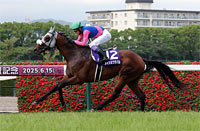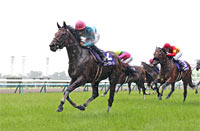2015 News
Data Analysis for the "2015 Takarazuka Kinen (G1)"Final accounts for the first half-year Though summer racing is already underway, the G1 Takarazuka Kinen could be seen as a race to settle accounts for the first half-year. In the past, this race has produced a number of epic battles between horses arriving via different routes. Some have fought their way through the spring’s G1 battle lines, while others have been conditioned specifically for this race, and others still have recently returned from overseas duty. This year, too, a high-level racing spectacle produced by a colorful array of contestants must again be assured. So now, let’s dig out some trends in this race from results over the last 10 years (including 2006, when it was held on the 2,200m turf course at Kyoto). Younger horses dominate Every winner of the Takarazuka Kinen over the last 10 years has been aged “6 and under”. What’s more, 28 of the 30 top 3 finishers have also been in this age bracket; the only ones aged “7 and over” to achieve this feat have been Narita Century, runner-up in 2006 when the race was held at Kyoto Racecourse, and that year’s 3rd place finisher Balance of Game (both aged 7). In fact, if we look further back at the 55 times this race has been held, only two horses aged “7 and over” have ever won – Speed Symboli in 1970 and Tap Dance City in 2004 (both aged 7). [Table 1] [Table 1] Performance by age (last 10 years)
Keep an eye on the win odds Over the last 10 years, three runners in the Takarazuka Kinen have been backed by win odds of “1.9 or less”, but only one has lived up to expectations – Deep Impact, winner in 2006 when the race was held at Kyoto. The other two have been beaten to 3rd or lower. By contrast, horses with odds of “2.0-2.9” have achieved a top 3 ratio of 100% and suffered no heavy defeats at all. Of the others, those with win odds of “10.0-14.9” and “30.0-49.9” have produced two winners each. So as well as the solidly reliable contenders in the “2” range, it would seem a good idea to watch for those regarded as dark horses. [Table 2] [Table 2] Performance by win odds (last 10 years)
Previous race also worth checking Turning to performances based on the runners’ previous race over the last 10 years, horses coming straight from the “Tenno Sho (Spring)” seem to have the greatest affinity for the Takarazuka Kinen – five of them have won. Of runners coming from other G1 races, those most recently seen in the “Victoria Mile”, though producing no winners, have achieved strong figures with a top 3 ratio of 42.9%. Excellent performances have also been produced by horses coming from 2,000m turf graded races regarded as warmups for the Takarazuka Kinen (the Kinko Sho up to 2011, the Naruo Kinen from 2012). In fact, runners previously appearing in the Kinko Sho (up to 2011)” or the “Naruo Kinen (from 2012)” have finished in the top 3 every year since 2008. [Table 3] [Table 3] Performance by previous race (last 10 years)
Check performances 2 and 3 races back In each of the last 10 years, horses with experience of “a top 2 finish in G2 two or three races back” have finished in the top 2 in the Takarazuka Kinen. Maybe having the talent to contend for top places in G2 races is a necessary condition for performing well on the G1 stage. It should be worth checking whether any of this year’s runners come with this kind of track record. [Table 4] [Table 4] Top 2 finishers in the Takarazuka Kinen with previous experience of a top 2 finish in G2 two or three races back (last 10 years)
*When there is more than one race in question, the most recent one is shown. Seek out the winners! On checking the recent performances of Takarazuka Kinen winners over the last 5 years, they have all both won a race and been beaten to 3rd or lower in a race within their most recent three outings. At the very least, a win within the last 3 races could be a condition for success here. [Table 5] [Table 5] Last 5 winners had finished both 1st and 3rd or lower in their previous three outings
*When there is more than one race in question, the most recent one is shown.
(Data analysis by Yasunori Asano) |
|
||||||||||||||||||||||||||||||||||||||||||||||||||||||||||||||||||||||||||||||||||||||||||||||||||||||||||||||||||||||||||||||||||||||||||||||||||||||||||||||||||||||||||||||||||||||||||||||||||||||||||||||||||||||||||||||||||||||||||||||||||||||||||||||||||




















